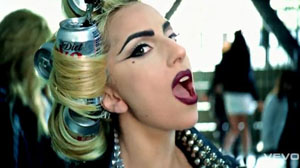
Product Placement
If the purpose of a TV programme is to herd consumers in the direction of the advertisers, then the traditional commercial break, when audiences stop paying attention to the TV set or computer and go off for a break or take the opportunity to switch channel, does not always do its job. DVRs and online viewing further threaten any kind of commercial which interrupts the programming.

The first instance of modern product placement, where a company negotiated to have its product feature as a major part of a story, is ET, where Reese's Pieces were the food of choice for the cuddly alien. M&Ms turned the offer down. Sales of Reese's Pieces went up astronomically.
Product placement is now an accepted part of movie and TV show financing (even for indie and low-budget productions), and we've got used to actors drinking from bottles that always have the label turned towards the camera. Problems arise, however, when the product placement seems too obvious or contrived, when the story slows just so the audience can get a good long look at a logo. Michael Bay seems to be a particular fan of product placement (because he works on such big budget movies) and the Transformers movies did seem like looooong commercials.
- Slideshow of product placement in the first Transformers movie (2007)- Worst Product Placement
Other producers are very careful and selective when it comes to product placement:
—Many Brands Bid for Product Placement on 'Modern Family,' but So Few Make ItHow to Get Your Product on 'Modern Family'
THINK ABOUT THE CHARACTERS, NOT YOUR MESSAGE:
How does your product fit into the lifestyle of one of the characters on the show? Producers don't want to disrupt the program by jamming in a box of soap that no one on it would consider using.EXPLAIN HOW YOUR SUPPORT CAN HELP MAKE "MODERN FAMILY" BETTER:
Producers want to take the cast to remote locations or bring in great guest stars. Can your advertising help accomplish that and make the show more exciting?BE PREPARED TO PONY UP:
Though no one is giving figures, back-of-the-envelope calculations indicate it could cost thousands of dollars per second and must be done alongside a traditional TV ad buy.DON'T GET YOUR HOPES UP:
Producers turn down about 90% of requests. No one wants the characters to turn into sales props.
Morgan Spurlock's 2011 documentary The Greatest Movie Ever Sold lifts the lid on how both moviemakers and corporate sponsors are prepared to cheat audiences when it comes to what many people see as back-door advertising. You'll never look at a movie the same way again.
Keep up to date with the latest news stories on product placement via the advertising category on the Mediaknowall blog.